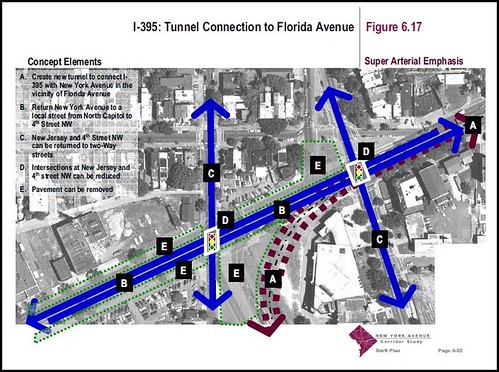(Not) Understanding DC's Competitive Positioning for Commerce
The Washington Business Journal has a piece, "Architect pitching global trade center for Mount Vernon Triangle," about a Chinese-American architect's idea to create an "international commerce center" over a chunk of I-395 at New York Avenue.
It's an interesting idea, but trade is a commerce-business phenomenon, not a political phenomenon, so the demand for businesses, especially international businesses, to locate in DC other than for lobbying purposes, is not great.
Compare with the old "Techworld" example. "Techworld" was supposed to be a national center for technology development, built on the block between 7th and 9th Streets on Mount Vernon Square. It's now nothing but undifferentiated office-commercial space.
Also see this relatively hilarious--in retrospect--1997 article from the Washington Business Journal, "D.C. convention center should spur development."
Businesses want to be close to their potential customers, or connected to industry knowledge and innovation clusters.
That's why the Ronald Reagan building, the "International Trade Center," fails as an "international trade center," not because it's run by government per se (although the high rents are a big issue), it's because it's located in a city that is not focused on the market economy and creating and nurturing businesses, and conducting trade. (A similar list of articles about the RRITC could be listed here, comparable to the list of articles above about TechWorld, e.g., "Reagan Building Nears Its Debut; Five Years in the Making, Federal Offices to Begin Opening Next Month" from 1997.)
L'Enfant's desires to make DC a center for national commerce were dashed 200 years ago--East Capitol Street was supposed to become the nation's commercial center--but it didn't and couldn't, because New York, Philadelphia, and Boston (among others) were already well-established, and because they had direct port access, back when water-borne transportation was the primary way to get around between nations and between cities.
Although, the proposal could help put forward ideas to tunnel part of New York Avenue, which was suggested for through traffic as part of the New York Avenue Transportation Plan, not quite 10 years ago.
Sadly, the proposal to tunnel "I-95" from the ending of I-395 at New York Avenue continuing eastbound to the DC border and the BWI Parkway has gone nowhere, but it does make a lot of sense.

Labels: economic development, real estate development, transportation planning



0 Comments:
Post a Comment
<< Home